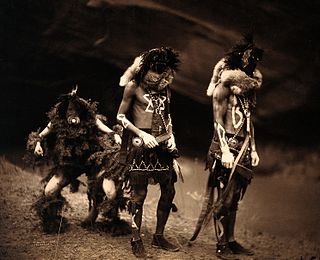
A medicine man or medicine woman is a traditional healer and spiritual leader who serves a community of Indigenous people of the Americas. Individual cultures have their own names, in their respective languages, for spiritual healers and ceremonial leaders in their particular cultures.

Shamanism or samanism is a religious practice that involves a practitioner interacting with the spirit world through altered states of consciousness, such as trance. The goal of this is usually to direct spirits or spiritual energies into the physical world for the purpose of healing, divination, or to aid human beings in some other way.

A sweat lodge is a low profile hut, typically dome-shaped or oblong, and made with natural materials. The structure is the lodge, and the ceremony performed within the structure may be called by some cultures a purification ceremony or simply a sweat.
A vision quest is a rite of passage in some Native American cultures. It is usually only undertaken by young males entering adulthood. Individual Indigenous cultures have their own names for their rites of passage. "Vision quest" is an English-language umbrella term, and may not always be accurate or used by the cultures in question.

The Sun Dance is a ceremony practiced by some Native Americans in the United States and Indigenous peoples in Canada, primarily those of the Plains cultures. It usually involves the community gathering together to pray for healing. Individuals make personal sacrifices on behalf of the community.

The Great Spirit is the concept of a life force, a supreme being or god, present in many, but not all, indigenous cultures in Canada and the United States. Interpretations of the Great Spirit also vary between cultures. It is known as Wakan Tanka in Lakota, Gitche Manitou in Algonquian, and by other, specific names in a number of First Nations and Native American cultures. According to Lakota activist Russell Means, a more semantically accurate translation of Wakan Tanka is the Great Mystery.
Neoshamanism refers to new forms of shamanism. It usually means shamanism practiced by Western people as a type of New Age spirituality, without a connection to traditional shamanic societies. It is sometimes also used for modern shamanic rituals and practices which, although they have some connection to the traditional societies in which they originated, have been adapted somehow to modern circumstances. This can include "shamanic" rituals performed as an exhibition, either on stage or for shamanic tourism, as well as modern derivations of traditional systems that incorporate new technology and worldviews.
Cultural appropriation is the inappropriate or unacknowledged adoption of an element or elements of one culture or identity by members of another culture or identity. This can be especially controversial when members of a dominant culture appropriate from minority cultures. According to critics of the practice, cultural appropriation differs from acculturation, assimilation, or equal cultural exchange in that this appropriation is a form of colonialism. When cultural elements are copied from a minority culture by members of a dominant culture, and these elements are used outside of their original cultural context – sometimes even against the expressly stated wishes of members of the originating culture – the practice is often received negatively.
The inípi ceremony, a type of sweat lodge, is a purification ceremony of the Lakota people. It is one of the Seven Sacred Ceremonies of the Lakota people, which has been passed down through the generations of Lakota.
Harley "Swiftdeer" Reagan (1941–2013) was an American pretendian and New Age spiritual leader. He is known for founding the Deer Tribe Metis Medicine Society and for developing Chulukua, a martial art, and Chuluaqui Quodoushka, a collection of sexual techniques and theories.

Smudging, or other rites involving the burning of sacred herbs or resins, is a ceremony practiced by some Indigenous peoples of the Americas. While it bears some resemblance to other ceremonies and rituals involving smoke from other world cultures, notably those that use smoke for spiritual cleansing or blessing, the purposes and particulars of the ceremonies, and the substances used, can vary widely among tribes, bands, and nations, and even more so among different world cultures. In traditional communities, Elders maintain the protocols around these ceremonies and provide culturally specific guidance. The smudging ceremony, by various names, has been used by others outside of the Indigenous communities as part of New Age or commercial practices, which has also led to the over-harvesting of some of the plants used in ceremonies. Indigenous people in the US and Canada have argued against appropriation and over-harvesting of white sage.

Indigenous intellectual property is a term used in national and international forums to describe intellectual property that is "collectively owned" by various Indigenous peoples, and by extension, their legal rights to protect specific such property. This property includes cultural knowledge of their groups and many aspects of their cultural heritage and knowledge, including that held in oral history. In Australia, the term Indigenous cultural and intellectual property, abbreviated as ICIP, is commonly used.

Native American religions are the spiritual practices of the Native Americans in the United States. Ceremonial ways can vary widely and are based on the differing histories and beliefs of individual nations, tribes and bands. Early European explorers describe individual Native American tribes and even small bands as each having their own religious practices. Theology may be monotheistic, polytheistic, henotheistic, animistic, shamanistic, pantheistic or any combination thereof, among others. Traditional beliefs are usually passed down in the forms of oral histories, stories, allegories, and principles.
Rolling Thunder aka John Pope, 1916–1997) was a hippie spiritual leader who self-identified as a Native American medicine man. He was raised in Oklahoma and later moved to Nevada. He has been considered an example of a plastic medicine man, with little or no genuine connection to the culture or religion he claimed to represent or study.
The red road is a modern English-language concept of the right path of life, as inspired by some of the beliefs found in a variety of Native American spiritual teachings. The term is used primarily in the Pan-Indian and New Age communities, and rarely among traditional Indigenous people, who have terms in their own languages for their spiritual ways. Native Americans' spiritual teachings are diverse. With over 500 federally-recognized tribes in just the US, while some regional practices and beliefs might be similar, the cultures are highly individualized. Individual ceremonies and particular beliefs tend to be unique to the people of these diverse bands, tribes and nations.

Michael James Harner was an anthropologist, educator and author. His 1980 book, The Way of the Shaman: a Guide to Power and Healing, has been foundational in the development and popularization of core shamanism as a New Age path of personal development for adherents of neoshamanism. He also founded the Foundation for Shamanic Studies.

Two-spirit is a modern, pan-Indian umbrella term used by some Indigenous North Americans to describe Native people in their communities who fulfill a traditional third-gender ceremonial and social role in their cultures.
Brooke "Medicine Eagle" Edwards is an American author, singer/songwriter and teacher, specializing in her interpretations of Native American religions. She frequently teaches workshops at New Age and other events.

Arvol Looking Horse is a Lakota Native American spiritual leader. He is the 19th keeper of the Sacred White Buffalo Calf Pipe and Bundle.

The modern Medicine Wheel symbol was invented as a teaching tool in about 1972 by Charles Storm, aka Arthur C. Storm, writing under the name Hyemeyohsts Storm, in his book Seven Arrows and further expanded upon in his book Lightningbolt. It has since been used by various people to symbolize a variety of concepts, some based on Native American religions, others newly invented and of more New Age orientation. It is also a common symbol in some pan-Indian and twelve-step recovery groups.











